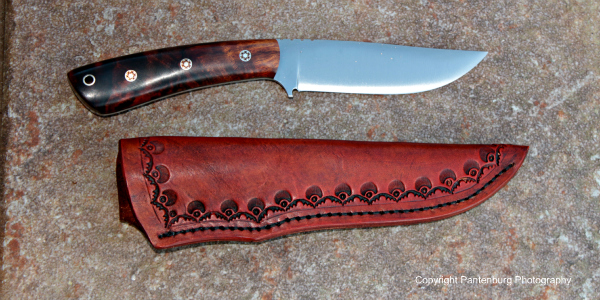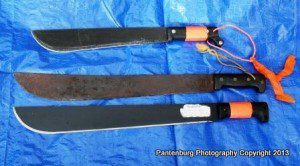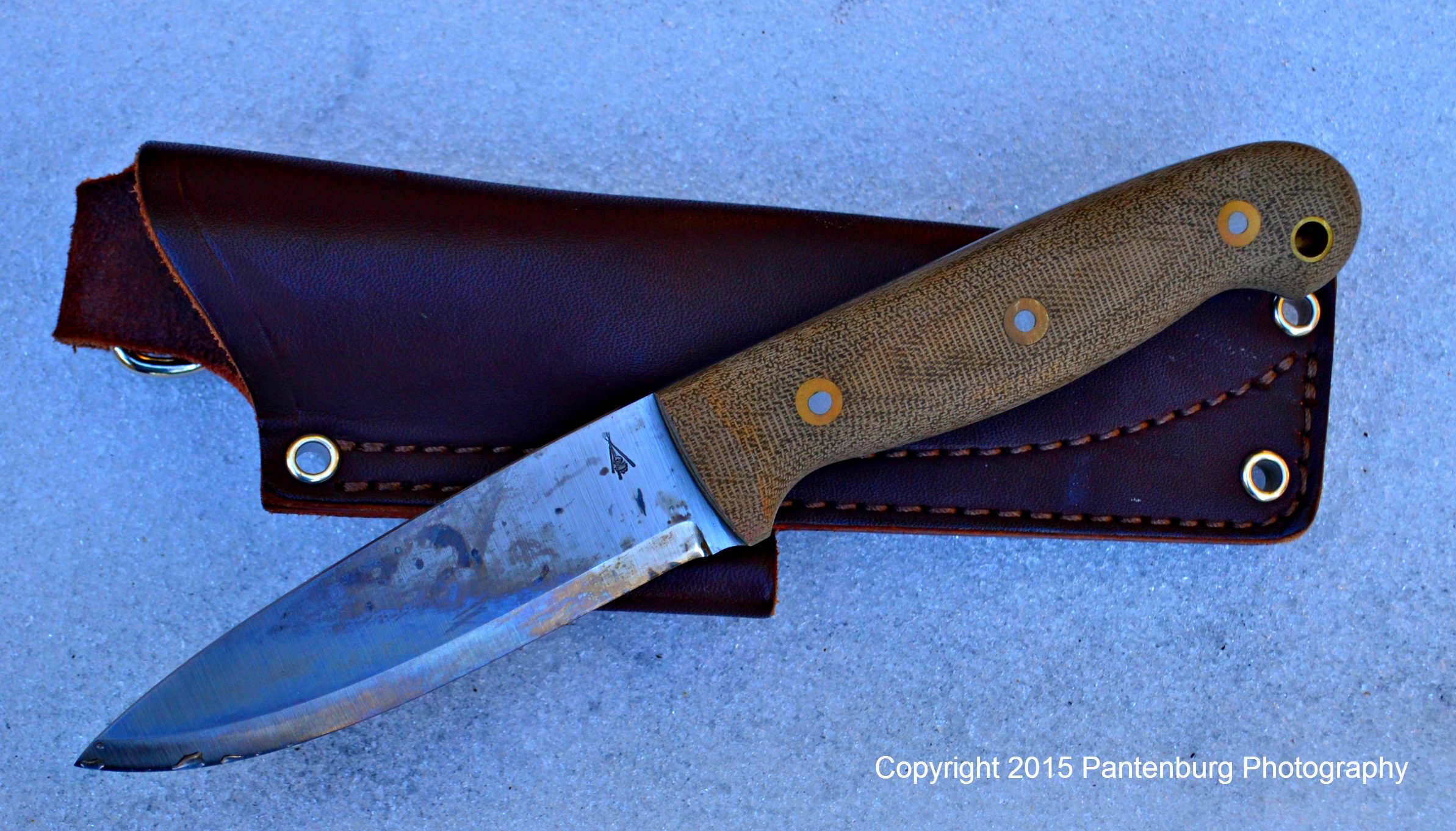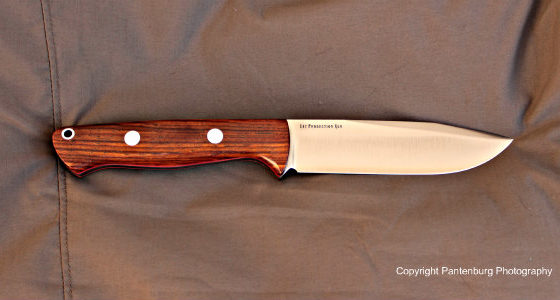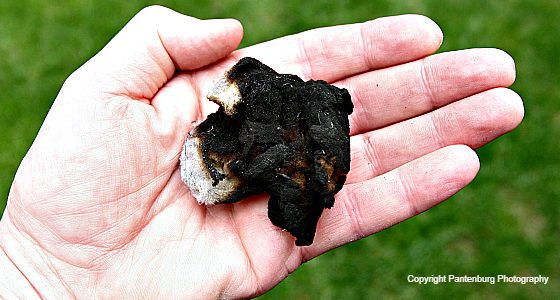Looking for a survival/bushcraft knife? How much blade do you need?
by Leon Pantenburg
Suppose you want to invest in a knife for bushcraft and/or overall outdoor use. Among the considerations is how long the blade should be. What do you need, and which length is best?
Beats me. Knife designs go in cycles, and size, handle material, color and shape can sometimes be related to the “fashion” of the times. Right now, it appears, the tactical-style and/or celebrity-endorsed knives are in favor. A newcomer might think these are the best choices.
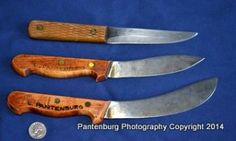
These replicas of frontier knives show that bigger blades were definitely in favor in the early 1800s.
There is also a connection between between blade length and thickness. A longer blade allows more leverage to be generated. But more leverage increases your chances of breaking the blade. Think of a short thick blade as a chisel, and a long, thin blade as more of a kitchen knife. A bushcraft/survival knife should be more of a shorter, thicker utility style.
Different areas and cultures, obviously, have different cutlery traditions, patterns and styles. Here’s how blade lengths apparently played out in America.
When people settled disputes by whacking away at each other with broadswords, blade lengths could be up to five feet.
Frontiersmen in the mid-1700s were commonly referred to as “Long Knives” by the indigenous people because a common cutlery tool was a “rifleman’s knife” with an eight-to-10-inch blade. Hunters who carried muzzle loader rifles frequently carried a big knife and a small two-to-three-inch “patch knife,” used to cut patching for loading the round ball.
When the Europeans headed west in the early to mid-1800s, a big knife was the do-it-all tool in their survival gear.
“A few of the popular models of knives used by the Indians and trappers were “Butcher Knife No. 15,” which had a six-inch blade and “Carving Knife No. 1586″ with an eight-inch blade. It was recorded that in the period of 1840 through 1860, the number of knives shipped to the far west was about 5,000 dozen. These sold at wholesale for $1.50 to $3.50 per dozen and retailed at the fur posts for from 50 cents to $1.50 each.” – Green River Knives” by Arthur Woodward, published in the 1950 Western Folklore.
Sales are always driven by consumer demand. If people on the frontier wanted a Mora-style knife, somebody would have supplied them.
During the early 1800s, the Bowie pattern was a popular backup to the sometimes-unreliable single shot muzzle loading firearms. In the 1980s, the Rambo movies introduced a whole new group to the Bowie concept.
So, today, how do you decide on the best blade length?
Here is a breakdown of blade lengths that have worked for me.
Utility knife: These typically have blade lengths of about 1/2-inch. Until you’ve used them, you can’t imagine how handy they are. I keep one on my garage work bench for miscellaneous cutting tasks where I don’t need to use my pocketknife. For opening dog food bags and fertilizer sacks, cutting paracord and ropes, and just about everything imaginable, a utility knife works just fine.
Anyone getting into preparedness/survival knives should get one of these. They typically cost under $10, the replacement blades are cheap, and the utility can save the edge of a more expensive knife.
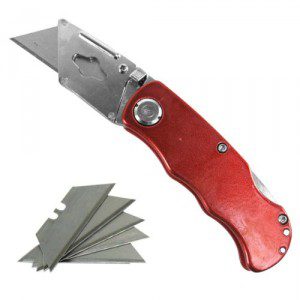
The cutting area of the blade on this utility knife measures about 1/2-inch.
One to two inches: This is about the size of a small blade on a pocket knife. I marked halfway of the 1.5 inch blade on my Swiss Army Knife with a marker and kept ![]() track of what I used the small blade for. Tasks ranged from cutting the plastic bands on bundles of newspapers, opening mail, whittling a stick to cutting string etc. For most of my urban everyday use, I was using less than an inch of the blade. Frequently, my tiny Swiss Army Classic did everything.
track of what I used the small blade for. Tasks ranged from cutting the plastic bands on bundles of newspapers, opening mail, whittling a stick to cutting string etc. For most of my urban everyday use, I was using less than an inch of the blade. Frequently, my tiny Swiss Army Classic did everything.
For small game hunting, the small spey blade of my Stockman pattern Puma pocketknife (about 1.5 inches) does most of the work. My Bucklite rides on my shotgun shell belt when I’m upland or waterfowl hunting. The drop point 2-3/4-inch blade is just right for field dressing game.
Three to four inches: This category includes folders and rigid blades. Three-to-four-inch blades will do everything when it comes to field dressing a whitetail or elk. I used a Buck folder with 3-1/2-inch blades very successfully for several years when I was starting out as a Mississippi deer hunter.
The guys I hunt elk with in Oregon generally use knives with a blade between three and four inches long. That length seems to be an ideal combination of efficiency, compactness and light weight.
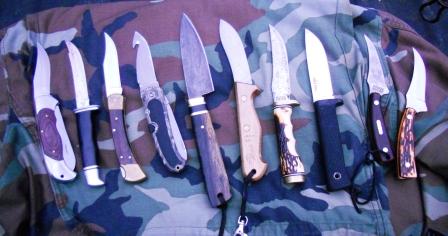
These knives are carried by the elk hunters I hunt with. The designs and style reflect a variety of opinions on knife design!
Don’t discount the efficiency. I used a three-inch Kellem Hawk to put down a large mule deer buck that had been hit by a car. The Hawk was all I had on me, and it did the job.
I’ve used a Cold Steel Master Hunter with complete satisfaction, and also recommend the Bark River Kalahari and Ambush Tundra. All are rigid blades with about a four-inch length. The ESEE-3 with a blade length of 3-7/8 inches is a good, usable choice. I also really like the L.T. Wright Genesis, with its 4-1/2-inch, A2 steel blade. (For more info, look at our Bark River Knife video reviews.)
Five to six inches: Generally speaking, a five-to-six inch blade on a hunting/survival knife is just right for me. For 20-some years, I carried a Cold Steel SRK as my do-it-all backcountry hunting/survival knife. The SRK has been used to field dress over 50 deer. The SRK six-inch blade worked really well, but I always thought the SRK would be a better knife with a five-inch blade.
I got a Bark River Sahara with a 5-1/2-inch, clip point blade as soon as they came out. The combination of handle design, blade length and quality A-2 steel makes it close to perfect for my hunting/survival knife needs.
For boning out meat, I like a five-inch, flexible blade. I experimented with different boning blade lengths and ended up liking a five-inch best. Other hunting buddies prefer the six-inch length. Use what you like. (Check out our video survival knife reviews.)
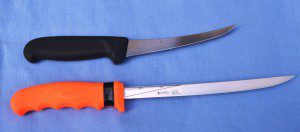
The Forshner six-inch boning knife, top, is a fine tool for filleting fish; the Cutco has a seven-to-nine inch adjustable blade. (Pantenburg photo)
Seven to eight inches: Knives for filleting fish or boning out meat fit into this category. The rule of thumb, I hear, is that the fillet knife blade should be about the same length as the fish that will be filleted.
I typically use a six-inch Forschner boning knife on panfish. My Cutco fillet knife has an adjustable-length blade between seven and nine inches. I use the seven-inch most on trout, larger panfish and catfish. The nine-inch length works better on salmon and larger ocean fish.
Up your game and get a Bark River Sportsman. Since I got mine in 2014, the Sportsman has become my most-used knife. It serves constantly in the kitchen, in camp and for elk and deer meat processing.
Eight to 12 inches: Knives with this length blade, IMO, are starting to become specialty knives. I use an eight-inch Old Hickory and a 10-inch Forschner for slicing roasts and certain tasks associated with butchering.
While I don’t want a bushcraft knife with a blade this long, there are certainly applications for them. The Bowie is in this size range, and for a fighter, I’m guessing a big blade would be best. Thankfully, I have no actual field experience with fighting knives!
Fourteen to 18 inches: These are lengths for machetes. In Iowa, we used these blades for cutting brush, chopping corn out of bean fields, or removing pollen tassels from corn.
My 14-inch machete is one of my most-used tools for mitering snow blocks to make igloos. It is also a handy size for chopping bamboo and cane. The longer blades work better for hacking brush entangled underbrush. Again, these are specialty blade lengths.
Every cutlery enthusiast has opinions about what makes the best knife. Depending on where you live, the anticipated uses of the knife and personal preferences, you may completely disagree with my choices.
But the bottom line is always going to be what works best for you. Choose wisely!
Please click here to check out and subscribe to the SurvivalCommonSense.com YouTube channel – thanks!

